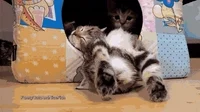DEM
warns public to remove coyote food sources from their property
 |
| These ARE NOT coyote snacks. Keep your kitties indoors. |
The
Rhode Island Department of Environmental Management (DEM) is advising residents
that this is the time of year when coyotes may often be seen in populated areas
and suburban neighborhoods in search of food.
DEM
advises the public not to feed or have food sources available that can be
easily accessed by coyotes or other wildlife.
Coyotes
that find abundant and easily obtained food resources around neighborhoods may
become bold and habituated to human activity, creating situations that are
detrimental to the animal and can also put small pets at risk.
Coyote
attacks on humans are a rare occurrence, but any coyote that exhibits bold or
aggressive behavior to humans should be treated with caution and reported to
authorities.
Coyotes
are opportunistic in their dietary habits, eating whatever is most abundant and
easily obtainable at a given time. Their natural diet typically consists of
prey such as small mammals, as well as wild and domestic fruits and berries,
when available.
Because
coyotes do not make a distinction between wildlife and domestic animals such as
house cats and small dogs, pet owners are advised to avoid keeping cats and
small dogs outdoors and unattended, particularly at night, to protect them from
encounters with coyotes or other wildlife.
DEM
also reminds the public to:
•
Keep bird feeders out of reach of wild animals. With warmer weather finally
approaching, natural food sources for birds are more plentiful now.
• Do
not feed pets outside, or, if you do, take pet food dishes inside at night.
•
Store garbage in sheds and garages, away from doors. Double bagging and the use
of ammonia will reduce odors that attract wildlife.
•
Put garbage for pickup outside the morning of collection, not the night before.
•
Keep barbecue grills clean of grease.
•
Do not put meat or sweet food scraps in your compost pile.
•
Enjoy wildlife from a distance.
Coyotes
in suburban areas may, because of their constant exposure to the sights and
sounds of human activity, become casual or even bold in their behavior – but
not necessarily aggressive toward people – and lose their fear of humans.
Despite
this, most coyotes usually make every attempt to avoid interactions with
people. Coyote attacks on people are very rare.
A
2009 study found that 159 people were bitten by coyotes in all of North America
between 1960 and 2006. On the other hand, more than 4.5 million people are
bitten by dogs each year in the United States, over half of dog bite injuries
occur at home with dogs that are familiar to us, and over 800,000 receive
medical attention for dog bites, according to the U.S. Centers for Disease
Control.
Coyotes
can often be discouraged simply by making yourself visible, and letting them
know, either by voice or other loud noises that they are not welcome. An
assertive posture and making eye contact will convey a message of authority
that coyotes will typically respect.
Should
a coyote exhibit aggressive, bold, or even curious behavior, in most cases it
is best to stand your ground and not run away. Animals that appear or act
aggressively or are noticeably sick should be reported to the DEM Division of
Law Enforcement (222-3070) or to your local animal control officer.
Adult
coyotes weigh approximately 40 pounds. The first appearance of coyotes in Rhode
Island occurred in the mid-1960s, part of a range expansion into the eastern
United States that began at the end of the 19th century.
Coyotes
can currently be found in all Rhode Island communities except New Shoreham.
They may hunt and travel alone or sometimes will travel as a group, usually an
adult pair with their offspring from the previous year.
In
our area, coyotes are mostly nocturnal, mainly to avoid interactions with
people. Coyote pairs are territorial, and will exclude other coyotes from their
established territory.
Coyotes
breed during late winter. Pups are born usually in April, 60-65 days after
breeding occurs. As pups grow and they begin the weaning process of eating
solid foods, the adults must spend greater time foraging, sometimes during
daylight hours.
For
more information on coyotes visit DEM's website at http://www.dem.ri.gov/.
Follow DEM on Facebook at www.facebook.com/RhodeIslandDEM or on Twitter
(@RhodeIslandDEM) for timely updates.
Related links